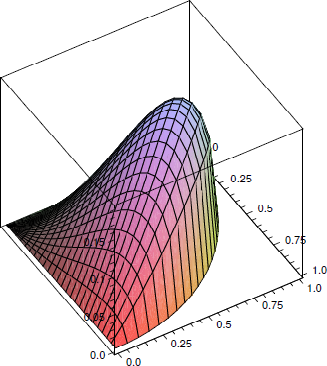14.7: Maxima and minima
( \newcommand{\kernel}{\mathrm{null}\,}\)
Suppose a surface given by
Likewise, in the plane
You will recall that in the single variable case, we examined three methods to identify maximum and minimum points; the most useful is the second derivative test, though it does not always work. For functions of two variables there is also a second derivative test; again it is by far the most useful test, though it does not always work.
Suppose that the second partial derivatives of
If
Verify that
Solution
First, we compute all the needed derivatives:
The derivatives
so there is a local minimum at
Find all local maxima and minima for
Solution
The derivatives:
Again there is a single critical point, at

Figure
Find all local maxima and minima for
Solution
The derivatives:
Again there is a single critical point, at
so we get no information. However, in this case it is easy to see that there is a minimum at
Find all local maxima and minima for
Solution
The derivatives:
Again there is a single critical point, at
so we get no information. In this case, a little thought shows there is neither a maximum nor a minimum at
Suppose a box with no top is to hold a certain volume
Solution
The area of the box is
Then
If we set these equal to zero and solve, we find
The second derivatives are
so the discriminant is
Since

Note that we must choose a value for
Recall that when we did single variable global maximum and minimum problems, the easiest cases were those for which the variable could be limited to a finite closed interval, for then we simply had to check all critical values and the endpoints. The previous example is difficult because there is no finite boundary to the domain of the problem---both
If
As in the case of single variable functions, this means that the maximum and minimum values must occur at a critical point or on the boundary; in the two variable case, however, the boundary is a curve, not merely two endpoints.
The length of the diagonal of a box is to be 1 meter; find the maximum possible volume.
Solution
If the box is placed with one corner at the origin, and sides along the axes, the length of the diagonal is
Clearly,
If these are both 0, then

Contributors
Integrated by Justin Marshall.



Here is the graph as rendered by Sage, as an example.